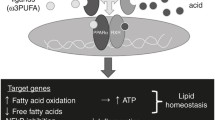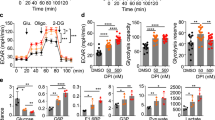Abstract
Kupffer cells (KCs) have been demonstrated to play a role in the regulation of intra-hepatic lipid metabolism through the synthesis and secretion of biologically active products. The involvement of KCs in the disturbance of lipid metabolism that induced by perfluorononanoic acid (PFNA), a known agonist of the peroxisome proliferator-activated receptor alpha (PPARα), was investigated in this study. Rats were exposed to PFNA or PFNA combined with gadolinium chloride, an inhibitor of KCs, for 14 days. PFNA exposure dose-dependently increased absolute and relative liver weights, induced triglyceride accumulation, up-regulated the expression of both SERBP-1c and PPARα, and stimulated the release of TNFα and IL-1β. Inactivation of KCs markedly lowered TNFα and IL-1β level, enhanced PFNA-induced expression of PPARα and its target genes, and reduced liver triglyceride levels. In vitro, PFNA-induced expression of PPARα in primary cultured hepatocytes was suppressed by recombinant rat TNFα and IL-1β. However, inhibition of the NF-κB pathway prevented this. Transient transfection and promoter analysis further revealed that these two cytokines and NF-κB were coordinately involved in the suppression of PPARα promoter activity. Our data demonstrate that TNFα and IL-1β released from KCs following PFNA exposure can suppress the expression of PPARα via NF-κB pathway, which partially contribute to the evident accumulation of triglycerides in rat liver.






Similar content being viewed by others
Abbreviations
- PFC:
-
Perfluorinated compound
- PFNA:
-
Perfluorononanoic acid
- TG:
-
Triglyceride
- TCHO:
-
Total cholesterol
- LPS:
-
Lipopolysaccharide
- IL-1β:
-
Interleukin-1 beta
- IL-10:
-
Interleukin-10
- IL-6:
-
Interleukin-6
- TNFα:
-
Tumor necrosis factor-alphaNF-κB, Nuclear factor kappa-light-chain-enhancer of activated B cells
- PPARs:
-
Peroxisome proliferator-activated receptors
References
Anderson SP, Yoon L, Richard EB, Dunn CS, Cattley RC, Corton JC (2002) Delayed liver regeneration in peroxisome proliferator-activated receptor-α-null mice. Hepatology 36:544–554
Babu AN, Damle SS, Moore EE, Ao L, Song Y, Johnson JL, Weyant M, Banerjee A, Meng X, Fullerton DA (2007) Hemoglobin-based oxygen carrier induces hepatic heme oxygenase 1 expression in Kupffer cells. Surgery 142:289–294
Bartolome N, Arteta B, Martinez MJ, Chico Y, Ochoa B (2008) Kupffer cell products and interleukin 1beta directly promote VLDL secretion and apoB mRNA up-regulation in rodent hepatocytes. Innate Immun 14:255–266
Bilzer M, Roggel F, Gerbes AL (2006) Role of KCs in host defense and liver disease. Liver Int 26:1175–1186
Calafat AM, Wong LY, Kuklenyik Z, Reidy JA, Needham LL (2007) Polyfluoroalkyl chemicals in the US population: data from the National Health and Nutrition Examination Survey (NHANES) 2003–2004 and comparisons with NHANES 1999–2000. Environ Health Perspect 115:1596–1602
Chen C, Hennig GE, Whiteley HE, Corton JC, Manautou JE (2000) Peroxisome proliferator-activated receptor alpha-null mice lack resistance to acetaminophen hepatotoxicity following clofibrate exposure. Toxicol Sci 57:338–344
Giesy JP, Kannan K (2001) Global distribution of perfluorooctane sulfonate in wildlife. Environ Sci Technol 35:1339–1342
Graham P, Brass NJ (1994) Multiple organ dysfunction: pathophysiology and therapeutic modalities. Crit Care Nurs Q 16:8–15
Hart K, Gill VA, Kannan K (2009) Temporal trends (1992–2007) of perfluorinated chemicals in Northern Sea Otters (Enhydra lutris kenyoni) from South-Central Alaska. Arch Environ Contam Toxicol 56:607–614
Hong F, Radaeva S, Pan HN, Tian Z, Veech R, Gao B (2004) Interleukin 6 alleviates hepatic steatosis and ischemia/reperfusion injury in mice with fatty liver disease. Hepatology 40:933–941
Huang W, Metlakunta A, Dedousis N, Zhang P, Sipula I, Dube JJ, Scott DK, O’Doherty RM (2010) Inactivation of liver Kupffer cells prevents the development of diet-induced hepatic steatosis and insulin resistance. Diabetes 59:347–357
Kang K, Reilly SM, Karabacak V, Gangl MR, Fitzgerald K, Hatano B, Lee CH (2008) Adipocyte-derived Th2 cytokines and myeloid PPARdelta regulate macrophage polarization and insulin sensitivity. Cell Metab 7:485–495
Kudo N, Kawashima Y (2003) Induction of triglyceride accumulation in the liver of rats by perfluorinated fatty acids with different carbon chain lengths: comparison with induction of peroxisomal β-oxidation. Biol Pharm Bull 26:47–51
Lau C, Anitole K, Hodes C, Lai D, Pfahles-Hutchens A, Seed J (2007) Perfluoroalkyl acids: a review of monitoring and toxicological findings. Toxicol Sci 99:366–394
Maher JM, Aleksunes LM, Dieter MZ, Tanaka Y, Peters JM, Manautou JE, Klaassen CD (2008) Nrf2- and PPAR alpha-mediated regulation of hepatic Mrp transporters after exposure to perfluorooctanoic acid and perfluorodecanoic acid. Toxicol Sci 106:319–328
Marra F, Gastaldelli A, Svegliati Baroni G, Tell G, Tiribelli C (2008) Molecular basis and mechanisms of progression of non-alcoholic steatohepatitis. Trends Mol Med 14:72–81
McMillian M, Nie AY, Parker JB, Leone A, Kemmerer M, Bryant S, Herlich J, Yieh L, Bittner A, Liu X, Wan J, Johnson MD (2004) Inverse gene expression patterns for macrophage activating hepatotoxicants and peroxisome proliferators in rat liver. Biochem Pharmacol 67:2141–2165
Mehendale HM (2000) PPAR-α: a Key to the Mechanism of hepatoprotection by clofibrate. Toxicol Sci 57:187–190
Minata M, Harada KH, Kärrman A, Hitomi T, Hirosawa M, Murata M, Gonzalez FJ, Koizumi A (2010) Role of peroxisome proliferator-activated receptor-alpha in hepatobiliary injury induced by ammonium perfluorooctanoate in mouse liver. Ind Health 48:96–107
Nelson JW, Hatch EE, Webster TF (2010) Exposure to polyfluoroalkyl chemicals and cholesterol, body weight, and insulin resistance in the general US population. Environ Health Perspect 118:197–202
Neyrinck AM, De Wispelaere LD, Vanhulle VP, Taper HS, Delzenne NM (2000) Are Kupffer cells involved in the metabolic adaptation of the liver to dietary carbohydrates given after fasting? Biochim Biophys Acta 1475:238–244
Neyrinck AM, Taper HS, Gevers V, Declerck B, Delzenne NM (2002) Inhibition of Kupffer cell activity induces hepatic triglyceride synthesis in fasted rats, independent of lipopolysaccharide challenge. J Hepatol 36:466–473
Odegaard JI, Ricardo-Gonzalez RR, Vats D, Morel CR, Goforth MH, Subramanian V, Mukundan L, Ferrante AW, Chawla A (2008) Alternative M2 activation of Kupffer cells by PPARdelta ameliorates obesity-induced insulin resistance. Cell Metab 7:496–507
Rivera CA, Bradford BU, Hunt KJ, Adachi Y, Schrum LW, Koop DR, Burchardt ER, Rippe RA, Thurman RG (2001) Attenuation of CCl(4)-induced hepatic fibrosis by GdCl(3) treatment or dietary glycine. Am J Physiol Gastrointest Liver Physiol 281:G200–G207
Rivera CA, Adegboyega P, van Rooijen N, Tagalicud A, Allman M, Wallace M (2007) Toll-like receptor-4 signaling and Kupffer cells play pivotal roles in the pathogenesis of non-alcoholic steatohepatitis. J Hepatol 47:571–579
Rusyn I, Tsukamoto H, Thurman RG (1998) WY-14 643 rapidly activates nuclear factor kappaB in Kupffer cells before hepatocytes in vito. Carcinogenesis 19:1217–1222
Smedsrød B, Pertoft H (1985) Preparation of pure hepatocytes and reticuloendothelial cells in high yield from a single rat liver by means of Percoll centrifugation and selective adherence. J Leukoc Biol 38:213–230
Stienstra R, Saudale F, Duval C, Keshtkar S, Groener JE, van Rooijen N, Staels B, Kersten S, Müller M (2010) Kupffer cells promote hepatic steatosis via interleukin-1beta-dependent suppression of peroxisome proliferator-activated receptor alpha activity. Hepatology 51:511–522
Taniyasu S, Kannan K, Horii Y, Hanari N, Yamashita NA (2003) Survey of perfluorooctane sulfonate and related perfluorinated organic compounds in water, fish, birds, and humans from Japan. Environ Sci Technol 37:2634–2639
Taniyasu S, Kannan K, So MK, Gulkowska A, Sinclair E, Okazawa T, Yamashita N (2005) Analysis of fluorotelomer alcohols, fluorotelomer acids, and short- and long-chain perfluorinated acids in water and biota. J Chromatogr A 1093:89–97
Yeung LW, Yamashita N, Taniyasu S, Lam PK, Sinha RK, Borole DV, Kannan K (2009) A survey of perfluorinated compounds in surface water and biota including dolphins from the Ganges River and in other waterbodies in India. Chemosphere 76:55–62
Youssef J, Badr M (1997) Activated Kupffer cells attenuate the liver response to the peroxisome proliferator perfluorooctanoic acid. Mol Cell Biochem 169:143–147
Zhang H, Shi Z, Liu Y, Wei Y, Dai J (2008) Lipid homeostasis and oxidative stress in the liver of male rats exposed to perfluorododecanoic acid. Toxicol Appl Pharmacol 227:16–25
Acknowledgments
This work was supported by the National Natural Science Foundation of China (grants 31025006, 20837004 and 21107078).
Author information
Authors and Affiliations
Corresponding author
Additional information
Xuemei Fang and Shanshan Zou have contributed equally to this paper.
Electronic supplementary material
Below is the link to the electronic supplementary material.
Rights and permissions
About this article
Cite this article
Fang, X., Zou, S., Zhao, Y. et al. Kupffer cells suppress perfluorononanoic acid-induced hepatic peroxisome proliferator-activated receptor α expression by releasing cytokines. Arch Toxicol 86, 1515–1525 (2012). https://doi.org/10.1007/s00204-012-0877-4
Received:
Accepted:
Published:
Issue Date:
DOI: https://doi.org/10.1007/s00204-012-0877-4




